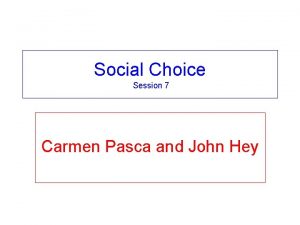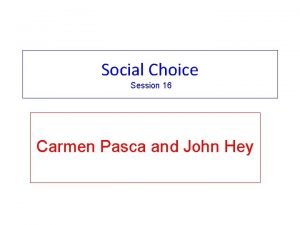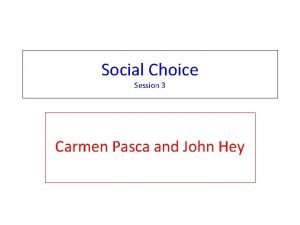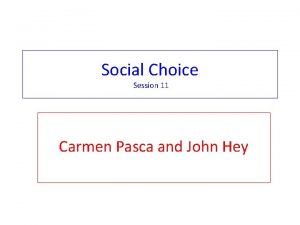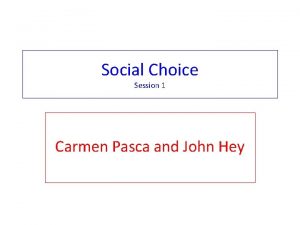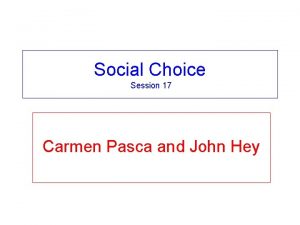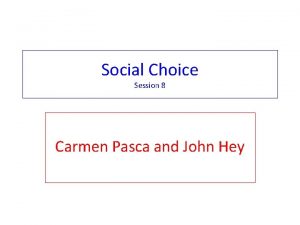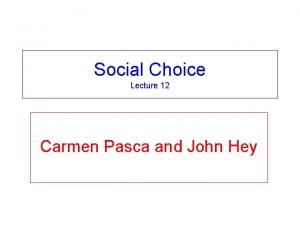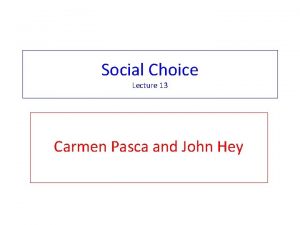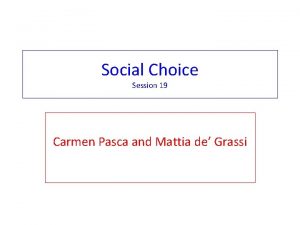Social Choice Session 6 Carmen Pasca and John













![Nash’s axioms • [See the Wikipedia article. ] • Invariant to affine transformations or Nash’s axioms • [See the Wikipedia article. ] • Invariant to affine transformations or](https://slidetodoc.com/presentation_image_h2/615c96368a912aac94bf000c229e534a/image-14.jpg)


- Slides: 16

Social Choice Session 6 Carmen Pasca and John Hey

Plan for today • Remember that we are trying to find/express Society’s preferences. • They come from individuals in society. So far we have shown that aggregating individual ordinal preferences is impossible. • We have shown that getting agreement on principles is impossible. • Today we are going to talk about aggregating individual cardinal/measurable preferences. Is this possible? • First we need to talk about existence of cardinal preferences. • We do this through Neumann-Morgenstern utility theory which seems to provide cardinality. • Then we talk about comparability. • We finish looking at Nash Bargaining Theory. • We conclude…?

Cardinal preferences • So far we have maintained the assumption that preferences are ordinal – just the ordering can be expressed. • This appears to have seriously constrained what we can do. • Surely we can measure intensity of preferences? And how increases in goods/consumption increases happiness? • Neumann-Morgenstern utility theory seems to let us do this. • So we can cardinally measure the utility of individuals. • The next tricky question is whether we can compare the happiness of different individuals. If we can, fine. . • …if not, perhaps we can borrow results from Nash Bargaining theory…

Our framework and assumptions • • • Denote Society’s utility/happiness by U. Individuals in society receive money income x. Denote i’s utility by ui = ui(xi). This could just be ui(xi) = xi but we keep it general. Then society’s happiness is some function of the ui. We could have U = (u 1 + … + u. I ) Egalitarian. Or U = min(u 1, … , u. I ) Rawlsian. Or U = max[(u 1 -ud)(u 2 -ud)] Nash special case Or… To make this operative the ui must be cardinal/measurable. (We concentrate on this and ignore in this session the issue of the form of the function. )

Notice the advantages of this • If society has a sum of money to distribute, then it can be done optimally through maximisation of Society’s welfare function. • We just have to agree on the form of the function. • Here we have assumed that the happiness of the members of society depends only on their money income… • … but if this method works it can be generalised… • …so that, for example, the happiness depends on goods and services consumed (this is not a big generalisation) and also depends on the consumption of goods and services by others in society.

Neumann-Morgenstern utility theory • • Is essentially a theory of decision-making under risk… …but does lead to a cardinal utility function. We constrain ourselves to money outcomes (as above). Fix end-points B and W (B>W) – the Best and Worst. Put u(W) = 0 and u(B) = 1. Like temperature – centigrade freezing is 00 boiling 1000. Let X be some amount of money between the best and the worst – W < X < B. • We are going to find u(X). • We can do this for any X – so we can find the utility function. • Note that this is individual specific.

How do we find utility values? • Easy peasy! • Ask “what must the probability p be to make you indifferent between getting X with certainty and playing out a lottery which gives you B with probability p and W with probability (1 -p)? ” p X for sure B indifferent with 1 -p W

So? p X for sure indifferent with 1 -p • • • B W Put u(B)=1 and u(W)=0. Then the utility of the left equals expected utility of the right: u(X) = pu(B) + (1 -p)u(W) = p*1 + (1 -p)*0 = p We have found the utility of X!!! Precisely p. Note that we can do this for any X (between B and W). Clever? !

Example with W= € 0, B= € 1000 and X= € 500 € 1000 0. 75 € 500 for sure indifferent with 0. 25 • • € 0 Put u(€ 1000)=1 and u(€ 0)=0. Then the utility of the left equals expected utility of the right: u(€ 500) = 0. 75 u(€ 1000) + 0. 25 u(€ 0) = 0. 75*1 + 0. 25*0 = 0. 75 We have found the utility of € 500 for an individual with the above preferences. • Clever? !

Implications • Using this method we can find the utility of any amount of money between W and B for any individual. • The shape of the function is individual specific. • It reflects the attitude to risk of the individual. • [Ask yourself: what is the form if the individual is risk-neutral (that is does not care/worry about risk)? ] • It is cardinal. • It depends upon the end points W and B. • If they change the function changes linearly. • This is exactly like temperature. Freezing and boiling temperatures: 0 and 100 Celsius, 32 and 212 Fahrenheit. • Temp Fahrenheit = 32 + (180/100)*Temp Celsius. Is this a problem?

Comparability? • Now let us ask about comparability. • We note that the utility function that we have derived is unique only up to a linear transformation • We need to fix end-points if we want to use these functions to find social welfare/happiness as in the previous slides. • Can we have the same end-points for everyone? • “Is Socrates dissatisfied happier than a pig satisfied? ” • During the 19 th and 20 th centuries most economists argued that one cannot measure happiness on an absolute scale. • But the idea is coming back into fashion. Andrew Oswald is a particularly energetic proponent. See his article on measuring and comparing International Happiness.

John Hey’s view • The idea of measuring happiness is cr*p. • To say that I am happier than Professoressa Pasca is meaningless. • But to say that I am happier today that yesterday has some merits. • And to say that B*rl*sc*n* is happier than Amanda Knox (and indeed most people in Italy) seems reasonable. • Perhaps it is OK to say that the Pope is happier than Ruby? • A hermit happier than a Ghedaffi? • Perhaps society needs to take a view? • But what is society? The Great and the Good? The Disinterested Few? Grand Old Men? We will see later…

One way out? • Nash Bargaining Theory. • Let us consider this with just two members in society u and v. • Suppose they are bargaining over money. If they do not reach agreement then they get some default d. • Suppose u gets x and v gets y if agreement is reached. • Nash showed that under some axioms (see the next slide) the solution is the allocation x to u and y to v such that the expression • [u(x)-u(d)][v(y)-v(d)] • is maximised.
![Nashs axioms See the Wikipedia article Invariant to affine transformations or Nash’s axioms • [See the Wikipedia article. ] • Invariant to affine transformations or](https://slidetodoc.com/presentation_image_h2/615c96368a912aac94bf000c229e534a/image-14.jpg)
Nash’s axioms • [See the Wikipedia article. ] • Invariant to affine transformations or Invariant to equivalent utility representations: so we do not worry about comparibility. • Pareto optimality: so there is no other solution which is better for both than this. • Independence of irrelevant alternatives: we have come across this before with Arrow. • Symmetry: the two individuals are treated symmetrically (by the state).

Extensions and problems • Can be extended to more than two people. • The same conclusions apply. • Its implementation requires all people in society to agree to the axioms, including symmetry. (Note this latter does not imply that x = y). • Problems? • We need to know the utility functions? • We already know how to find them. • But our method requires that people answer honestly. • Is it in their own interests so to do? • Question for the nonna.

Conclusions • • • We started this lecture with a long liturgy of impossibilities… …but with hope in our hearts. We ended it with less hope and more impossibilities… …but greater clarity about what ‘The State’ needs to know. We need to judge what the State does, not from our own selfish perspectives, but as Grand Old Men taking a benevolent and disinterested view of Society. But another question strikes us at this stage: “Why do we need a State at all? Why can we not just let the individuals in society get on and run it by themselves? ”. What is wrong with anarchy? Or perhaps a little anarchy? We move on to this in the next session.
 Good choice or bad choice
Good choice or bad choice Aglaonema dikenal juga dengan
Aglaonema dikenal juga dengan Tamhidi meaning
Tamhidi meaning Pengertian pasca produksi
Pengertian pasca produksi Teori evolusi pasca darwin
Teori evolusi pasca darwin Penyelesaian audit dan tanggung jawab pasca audit
Penyelesaian audit dan tanggung jawab pasca audit Pasca panen telur
Pasca panen telur Penanganan pasca panen serealia
Penanganan pasca panen serealia Profilaksis pasca pajanan hiv
Profilaksis pasca pajanan hiv Perancangan taraf
Perancangan taraf Pasca perkhidmatan jpa
Pasca perkhidmatan jpa Fisiologi pasca panen adalah
Fisiologi pasca panen adalah Pasca panen lada
Pasca panen lada Pasca konstruksi adalah
Pasca konstruksi adalah Ayat tetapi
Ayat tetapi Higeri
Higeri Perkembangan kolonialisme dan imperialisme
Perkembangan kolonialisme dan imperialisme

















